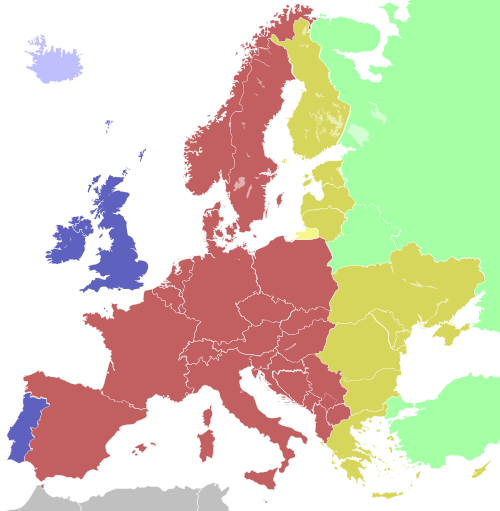Central European Summer Time

| blue | Western European Time (UTC+0) Western European Summer Time (UTC+1) |
| light blue | Western European Time (UTC+0) |
| red | Central European Time (UTC+1) Central European Summer Time (UTC+2) |
| yellow | Eastern European Time (UTC+2) Eastern European Summer Time (UTC+3) |
| orange | Kaliningrad Time (UTC+3) |
| green | Moscow Time (UTC+4) |
Central European Summer Time (CEST, UTC+02:00) (sometimes called Central European Daylight Time) is the name for a time zone. It is a daylight saving time.[1] Some of the countries that have Central European Time shift their clocks forward one hour, during the summer months and shift it one hour backwards during winter months.[2]
A research station called Troll in Antarctica uses this time zone in the winter, but uses Greenwich Mean Time in the summer.[3]
The part of Europe using this time zone has had many changes from Central European Summer Time. It is because the Sun is not matching with the time in their areas. They have also stopped using the timezone multiple times.[4]
Where it is used
The following countries and territories use Central European Summer Time:[5]
- Albania, since 1974
- Andorra, since 1985
- Austria, since 1980
- Belgium, since 1980
- Bosnia and Herzegovina, since 1983 when part of Yugoslavia
- Croatia, since 1983 when part of Yugoslavia
- Czech Republic, since 1979 when part of Czechoslovakia
- Denmark (metropolitan), since 1980
- France (metropolitan), since 1976
- Germany, since 1980
- Gibraltar, since 1982
- Hungary, since 1980
- Italy, since 1968
- Kosovo, since 1983 when part of Yugoslavia
- Liechtenstein, since 1981
- Luxembourg, since 1981
- Malta, since 1974
- Monaco, since 1976
- Montenegro, since 1983 when part of Yugoslavia
- Netherlands, since 1977
- North Macedonia, since 1983 when part of Yugoslavia
- Norway, since 1980
- Poland, since 1977
- San Marino, since 1966
- Serbia, since 1983 when part of Yugoslavia
- Slovakia, since 1979 when part of Czechoslovakia
- Slovenia, since 1983 when part of Yugoslavia
- Spain, since 1974 (except Canary Islands, which instead apply Western European Summer Time)
- Sweden, since 1980
- Switzerland, since 1981
- Vatican City, since 1966
The following countries have also used Central European Summer Time in the past:
References
- ↑ "CEST time zone — Central European Summer Time". 24timezones.com. Retrieved 2022-12-31.
- ↑ Slater, Jack (2022-08-01). "What is CEST and what's the difference to time in the UK?". Metro. Retrieved 2022-12-31.
- ↑ "Central European Summer Time – CEST Time Zone". www.timeanddate.com. Retrieved 2022-12-31.
- ↑ Tidey, Alice (2022-10-28). "When will the EU end seasonal clock changes? Only time will tell". euronews. Retrieved 2022-12-31.
- ↑ "CEST – Central European Summer Time (Time Zone Abbreviation)". www.timeanddate.com. Retrieved 2018-07-20.